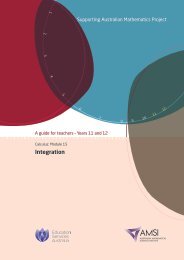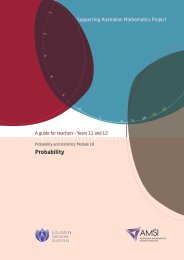PDF Version of module - the Australian Mathematical Sciences ...
PDF Version of module - the Australian Mathematical Sciences ...
PDF Version of module - the Australian Mathematical Sciences ...
You also want an ePaper? Increase the reach of your titles
YUMPU automatically turns print PDFs into web optimized ePapers that Google loves.
{8} A guide for teachersWhat is <strong>the</strong> chance <strong>of</strong> getting 11? There are two ways <strong>of</strong> getting 11; we could get a 5 onred & a 6 on blue or a 6 on red and a 5 on blue. These have no overlap, so we find <strong>the</strong>probability <strong>of</strong> (6, 5) or (5, 6) happening by adding <strong>the</strong>ir probabilities, giving us 136 + 136 = 236 .Similarly, <strong>the</strong> possible equally-likely outcomes to give a total <strong>of</strong> 10 are (4, 6), (5, 5), or (6, 4).There is no overlap in <strong>the</strong>se – that is, if one happens <strong>the</strong>n <strong>the</strong> o<strong>the</strong>rs can’t – so <strong>the</strong> chance<strong>of</strong> getting a total <strong>of</strong> 10 is found by adding up <strong>the</strong> individual probabilities, giving us136 + 136 + 136 = 336 .EXAMPLE C: WHAT IS THE CHANCE THE WINNING TICKET IS ONETHAT YOU SOLD?Raffles are usually run by people buying numbered (and sometimes coloured) tickets with<strong>the</strong> tickets being in two parts. The buyers keep one part and <strong>the</strong> o<strong>the</strong>r parts (we’ll call <strong>the</strong>m<strong>the</strong> ticket stubs) are put into a container with someone picking out a ticket at random from<strong>the</strong> container. The outcomes <strong>of</strong> <strong>the</strong> draw are all <strong>the</strong> tickets that have been sold.Often different coloured books <strong>of</strong> tickets are used, so that <strong>the</strong> winning ticket might becalled out as “blue, number 16”. Suppose <strong>the</strong>re are 5 ticket-sellers and each one has abook <strong>of</strong> 100 tickets and each book is a different colour. You are a seller and your book isgreen. All <strong>the</strong> tickets are sold. The stubs are put in a container and mixed well, and a guestpulls one out (without looking <strong>of</strong> course!). So <strong>the</strong>re are 500 ticket stubs in <strong>the</strong> containerand <strong>the</strong>y are all equally-likely to be drawn. You sold 100 <strong>of</strong> <strong>the</strong>se. So <strong>the</strong> chance <strong>of</strong> anyone <strong>of</strong> <strong>the</strong> tickets you sold being selected is 1500 , and only one ticket can win. The chancethat one <strong>of</strong> <strong>the</strong> 100 tickets you sold will be drawn is <strong>the</strong> sum over <strong>the</strong> 100 tickets <strong>of</strong> <strong>the</strong>chance <strong>of</strong> each <strong>of</strong> <strong>the</strong>m winning. Summing 1100500 100 times gives 500 = 0.2 that <strong>the</strong> winningticket will be one that you sold.EXAMPLE D: WHICH DESTINATION WILL THE CONTESTANT WIN FORA HOLIDAY?In a TV contest, a contestant wins a holiday in Australia.Suppose <strong>the</strong> contestant is blindfolded and places a pin on a board with <strong>Australian</strong> regionsrandomly placed on <strong>the</strong> map but with different areas <strong>of</strong> <strong>the</strong> board assigned to differentregions, with no overlap <strong>of</strong> regions. If <strong>the</strong> regions and <strong>the</strong>ir areas on <strong>the</strong> board are asfollows, what is <strong>the</strong> chance <strong>the</strong> contestant will win a holiday in Queensland?Queensland: 12 cm 2NSW: 8 cm 2Vic: 4 cm 2SA: 8 cm 2WA: 16 cm 2Tas: 2 cm 2NT: 9 cm 2ACT: 1 cm 2
















